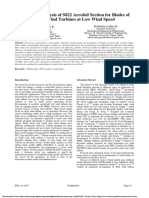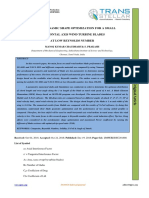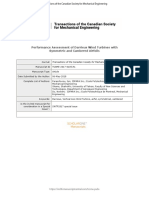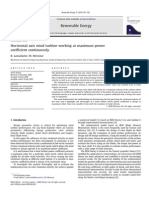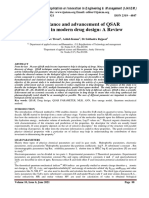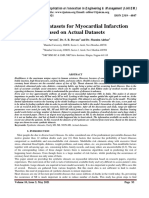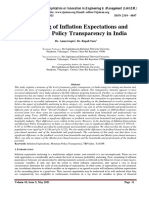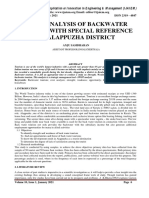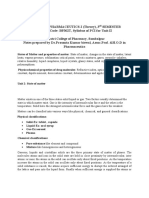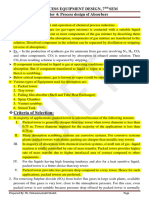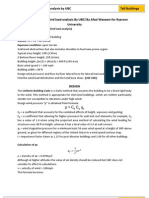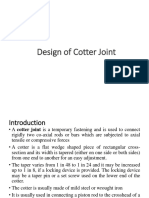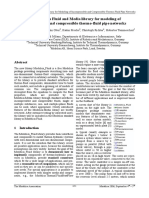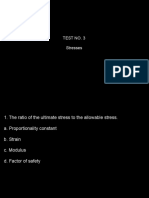CFD Analysis & Experimental Investigation of NACA0018 Blade Profile For Darrieus Turbine
CFD Analysis & Experimental Investigation of NACA0018 Blade Profile For Darrieus Turbine
Copyright:
Available Formats
CFD Analysis & Experimental Investigation of NACA0018 Blade Profile For Darrieus Turbine
CFD Analysis & Experimental Investigation of NACA0018 Blade Profile For Darrieus Turbine
Original Title
Copyright
Available Formats
Share this document
Did you find this document useful?
Is this content inappropriate?
Copyright:
Available Formats
CFD Analysis & Experimental Investigation of NACA0018 Blade Profile For Darrieus Turbine
CFD Analysis & Experimental Investigation of NACA0018 Blade Profile For Darrieus Turbine
Copyright:
Available Formats
IPASJ International Journal of Mechanical Engineering (IIJME)
Web Site: http://www.ipasj.org/IIJME/IIJME.htm
Email:editoriijit@ipasj.org
ISSN 2321-6441
A Publisher for Research Motivation ........
Volume 4, Issue 8, August 2016
CFD Analysis & Experimental investigation of
NACA0018 Blade Profile for Darrieus Turbine
Vikas Gorakh Pathade 1, Kishor B. Kale2 ,Sagar Kailas More3
1
Student, Department of Mechanical Engineering, P.D.V.V.P.C.O.E., Ahmednagar.
Head of Department, Department of Mechanical Engineering, P.D.V.V.P.C.O.E., Ahmednagar.
3
Student, Department of Mechanical Engineering, P.D.V.V.P.C.O.E., Ahmednagar.
ABSTRACT
In present work an attempt is made to investigate the Lift and Drag forces for wind turbine blade at 4000 Reynolds number and
different chord length i.e.15cm & 25 cm. In this work NACA0018 airfoil profile is considered for analysis of wind turbine
blade. The Lift and Drag forces are calculated at different angle of attack varying from 0o to 80o by Computational Fluid
Dynamics (CFD) analysis. The values of CL and CD for this Reynolds number is much important in analysis of Darrieus and
horizontal axis type of wind turbine blade, still it these values are not available from the literature reviewed . From CFD
analysis it is concluded that as Reynolds number increase lift forces and drag forces decreases for particular chord length and
if chord length increases CL and CD increases. And Comparison has been done on NACA0018 for all two chord length and
from that we concluded that NACA0018 at 15cm provides maximum lift and drag.
Keywords: Lift coefficient, Drag coefficient, angel of attack, NACA Blade profile, Chord length.
1. INTRODUCTION
Due to day by day increase in populations in India and world there is need simple economical device which will
produce electricity very fast and at very low cost. This need of modern society will be fulfill by simple three blade wind
turbine which is called darreius turbine. Selection of aero foil shape of blade is the most critical part of a wind turbine
design as ultimately blade is responsible for conversion of kinetic energy into mechanical energy. Aerodynamics is a
science and study of physical laws of the behavior of objects in airflow and the forces that are produced by airflows.
Aerodynamic performance of wind turbine blades can be analyzed using Computational Fluid Dynamics (CFD), which
is one of the branches of fluid mechanics. Aerodynamic studies are quite mature for flows with large Reynolds number.
However, there are not much analytical, numerical or experimental studies available for flows at very low Reynolds
numbers. In order to extract the maximum kinetic energy from wind, researchers put much effort on the design of
effective blade geometry. Consideration of 2D geometries, i.e., airfoils, for such studies seems to be a good starting
point to improve understanding of higher Reynolds number flows.In this regard, some experimental studies are
reported in Schmitz F. W., 1967, Sunada S. et al., 1997 [1], Sunada S. et al., 2002 [2], M.Nazmul 2015 [3]. The effects of
aerofoil profile modification on a vertical axis wind turbine performance are presented in by MdFarathIsmail,
Krishanavijayrahgavan 2015 [4]. The effect of Blockage-tolerant wind tunnel measurements for a NACA 0012 at high
angles attack is presented by J.M Rainbird , J .Peiro 2015 [5].N. Rostamzadeh et al.2012[6] has performed novel
variation on tubercles was employed to modify a NACA0021 airfoil for wind tunnel pressure measurement tests in the
transitional flow regime. K. E. Swalwell et al. 2001[7] has done investigation effect of turbulence intensity on stall of the
NACA0021 aerofoil increasing the turbulence intensity delayed stall until higher angles of attack. Further they
investigated the reasons for this delay, to repeat this experiment on a thick cambered aerofoil and to assess the likely
effect on wind turbine performance. Bhushan S Patil et al[8] has performed CFD analysis of wind turbine at various
angle of attack and different Reynolds number for blade NACA0012. From literature survey, it is observed that, study
of lift and drag forces on aerofoil, for very low Reynolds number at different angle of attack is not explode more. In this
present work an attempt is made to study the Lift and Drag forces on a wind turbine blade for very low Reynolds
number i.e.4000 and different angle of attack. In present work NACA0018 airfoil profile is considered for analysis of
wind turbine blade. The Lift and Drag forces are calculated at different angle of attack from 0o to 80o for Reynolds
number is 4000 and also for two different chord i.e. 15cm and 25cm lengths by computational fluid dynamics analysis.
Volume 4, Issue 8, August 2016
Page 1
IPASJ International Journal of Mechanical Engineering (IIJME)
Web Site: http://www.ipasj.org/IIJME/IIJME.htm
Email:editoriijit@ipasj.org
ISSN 2321-6441
A Publisher for Research Motivation ........
Volume 4, Issue 8, August 2016
1.1 Lift Coefficient (CL):- It is a dimensionless coefficient that relates the lift generated by aerofoil, the dynamic
pressure of the fluid flow around aerofoil, and a reference area associated with the body. This is given as follows
L
CL =
Lift force (L) =
CL
1 2 A
2
1.2 Drag Coefficient (CD): It is a dimensionless quantity that is used to quantify the drag or resistance of an object in a
fluid environment such as air for aerofoil. This is given as follows
D
CD
, Drag force (D) =
2
1
CD
1.3 Angle Of Attack ( ): The angle of attack is the angle between an airfoil cord line and the oncoming air.
2. GEOMETRY AND MESH GENERATION
In present analysis, C type mesh with two way velocity inlet method is used. The close view of mesh and boundary
condition used in analysis is shown in fig.2 and fig.1 respectively. The pressure based implicit steady solver with
Standard k- model turbulence model with PRESTO second order upwind scheme is used for analysis.
Fig. 1 Geometry with boundary conditions
Fig. 2. Close view of C type mesh for NACA0012
2.1 GRID INDEPENDENCE TESTS
Grid Independence Tests are performed for finding the least resolution or number of cells required to obtain accurate
solutions. It is helpful in saving time and memory space in working out a numerical simulation. In this method one or
parameters are obtained at various resolutions, starting from lower to higher. As the number of cells increases the
parameter converges to an asymptotical value indicating the accuracy of solutions and minimum cells required for it.
By doing the Grid Independence Test we will be able to save the computational time. The Grid Independence Test was
done for an airfoil at 10 degree angle of attack by the above Boundary conditions by using all the turbulence models.
The figures given below are the graphs for Grid Independence Test, for an airfoil at 10 degree angle of attack for the kturbulence model. The k- turbulence model converges needs more number of iterations as compared to the other
two models. Hence the results shown below are plotted for the k- model Lift Coefficient, Drag Coefficient and for the
different element size. Based on the results, we can select the element size of 14040 as the best element size.
Fig.3. Grid independence study mesh
Volume 4, Issue 8, August 2016
Page 2
IPASJ International Journal of Mechanical Engineering (IIJME)
A Publisher for Research Motivation ........
Volume 4, Issue 8, August 2016
Web Site: http://www.ipasj.org/IIJME/IIJME.htm
Email:editoriijit@ipasj.org
ISSN 2321-6441
3. RESULTS AND DISCUSSION
3. 1. NACA0018: Initially, CFD analysis is carried out for NACA0018 and two different chord length 15cm, 25cm, for
Reynolds number 4000. Geometric details are shown in Fig.1. Map meshed used for simulation, close view of map
mesh used near aerofoil is shown in Fig.2. The obtained results are plotted in fig.4 to fig.11 for angle of attack 10 to
80 respectively on velocity contour around aerofoil.
As per our angle of attack is changing 10 to 80 formation of wake is changing and has been observed from the fig. at
higher angle of attack 50 to 80 flow get diverted and due to separation of flow phenomenon of stalling is observed.
Because of stalling our lift coefficient is decreases at higher angle of attack i.e. 50 to 80.
Fig. 4. Velocity contour for angle of attack 100
Fig. 6. Velocity contour for angle of attack 300
Fig. 8. Velocity contour for angle of attack 500
Volume 4, Issue 8, August 2016
Fig. 5. Velocity contour for angle of attack 200
Fig. 7. Velocity contour for angle of attack 400
Fig. 9. Velocity contour for angle of attack 600
Page 3
IPASJ International Journal of Mechanical Engineering (IIJME)
A Publisher for Research Motivation ........
Volume 4, Issue 8, August 2016
Fig. 10. Velocity contour for angle of attack 700
Web Site: http://www.ipasj.org/IIJME/IIJME.htm
Email:editoriijit@ipasj.org
ISSN 2321-6441
Fig. 11. Velocity contour for angle of attack 800
4. EXPERIMENTAL INVESTIGATION AND VALIDATION
4.1 INTRODUCTION
Free flow wind turbines are one of the best known renewable energy sources among the other renewable sources like
solar and wind energy. Wind turbine electricity generation is mainly aimed for rural use at sites remote from existing
electricity grids. It is a useful tool for improving the quality of life of people in these locations and for stimulating local
economies. The energy in wind is predictable and reliable energy resource is available 24 hours a day. Wind turbine
can extract power from wind. These turbines generate electricity using the kinetic energy of natural wind resources
using different types of rotors. These rotors are fixed to a structure on the riverside. These devices are easy to transport
and relocate.
So for after CFD analysis, it has been decided that to do experimental testing on wind tunnel located at Chhatrapati
College of engineering, Ahmednager. So testing has been done on wind tunnel set for NACA0018 -15 cm, 25 cm
which are the optimize blade profile obtained from CFD. Experimental Set up details are given below.
(a)Apparatus used in experimentsWind tunnel, Pitot tube and manometer, Variable frequency drive (VFD), Digital display attached with wind tunnel.
(b)Wind Tunnel- Wind tunnel apparatus is used for calculating lift and drag force of aerofoil. Forced convection air
flow by blower is used on statically placed aerofoil in a box for calculating lift and drag force developed by restricting
air flow by aerofoil. The aerofoil is fixed by fixing stand with an adjustment of rotating the aerofoil for setting required
angle of attack
(c)Specification of wind tunnel:1. Length = 92 cm
2. Width & height = 28 cm
4.2Pitot tube and ManometerPitot tube is attached with aerofoil to measure the pressure head developed. And to achieve required Reynolds number.
This is used to calculate velocity of air , the Pitot tube shown below used for measure pressure.
4.3Variable Frequency Drive (VFD)- Variable Frequency Drive is for adjusting speed of blower and pressure head
i.e. speed of air by varying frequency of blower. It is very with highly accurate instrument. It is very advance
instruments.
4.4 Digital Display- For displaying Lift and drag coefficients:
The digital display is provided for displaying lift and drag coefficients obtained from aerofoil by setting different angle
of attack on wind tunnel. These displays are highly accurate and extremely good in profile manner
Volume 4, Issue 8, August 2016
Page 4
IPASJ International Journal of Mechanical Engineering (IIJME)
A Publisher for Research Motivation ........
Volume 4, Issue 8, August 2016
Web Site: http://www.ipasj.org/IIJME/IIJME.htm
Email:editoriijit@ipasj.org
ISSN 2321-6441
Digital Display- For displaying Lift and drag coefficients.
4.5Aerofoil: Two aerofoil are manufacture on CNC and made of FRP. The blade profile is used is NACA0018 and two
chord length are tested 15 cm and 25 cm.
Figure 12: Aero foil
Procedure of wind tunnel testing
1) Aerofoil is set in the test section of the wind tunnel at a small angle (a=10o ) of attack with the help of
inclinometer.
2) Multi tube manometer is adjusted so that all tubes are levelled.
3) All pressure tapping from top and bottom site of aerofoil is connected to multi tube manometer.
4) The motor of wind tunnel is started at the required running speed and the velocity of wind in test section is
determined with the help of anemometer.
5)For this particular angle of attack (a=10o ) values of static and dynamic pressure H1 and Hx are obtained for all
the pressure tapping.
6)Now change the angle of attack with the help of inclinometer (now (a=20o )and note down the values of static and
dynamic pressure H1 and Hx for all the pressure tapping.
4.6 Testing for NACA0018 for chord length 15 cm:
Following observations are observed with wind tunnel set up on NACA0018 aerofoil at Re=4000
Table No. 1
Sr. No.
Angle of attack
Lift coefficient
Drag coefficient
1
2
3
4
5
6
7
8
10
20
30
40
50
60
70
80
0.06
0.13
0.21
0.49
0.3
0.18
0.12
0.10
0.04
0.06
0.09
0.15
0.13
0.24
0.118
0.29
From observation table and graphs on next pages it observed that if same Reynolds number lift coefficient increase with
increase in angle of attack and it reaches maximum value suddenly decreases, this phenomena called as stalling.
Volume 4, Issue 8, August 2016
Page 5
IPASJ International Journal of Mechanical Engineering (IIJME)
A Publisher for Research Motivation ........
Volume 4, Issue 8, August 2016
Web Site: http://www.ipasj.org/IIJME/IIJME.htm
Email:editoriijit@ipasj.org
ISSN 2321-6441
4.7 Testing for NACA0018 for chord length 25 cm:
Following observations are observed with wind tunnel set up on NACA0018 aerofoil at Re=4000
Table No. 2
Sr. No.
Angle of attack
Lift coefficient
Drag coefficient
1
2
3
4
5
6
7
8
10
20
30
40
50
60
70
80
0.08
0.10
0.12
0.13
0.24
0.18
0.09
0.08
0.02
0.06
0.08
0.21
0.16
0.24
0.28
0.32
From observation table and graphs on next pages it observed that if same Reynolds number lift coefficient increase with
increase in angle of attack and it reaches maximum value suddenly decreases, this phenomena called as stalling.
Volume 4, Issue 8, August 2016
Page 6
IPASJ International Journal of Mechanical Engineering (IIJME)
A Publisher for Research Motivation ........
Volume 4, Issue 8, August 2016
Web Site: http://www.ipasj.org/IIJME/IIJME.htm
Email:editoriijit@ipasj.org
ISSN 2321-6441
4.8 Validations and comparison of experimental and CFD results for NACA0018-15 cm and 25 cm:
4.8.1 NACA0018-15 CM:
Table No. 3
Angle of attack
10
20
30
40
50
60
70
80
Lift coefficient EXP
0.06
0.13
0.21
0.49
0.3
0.18
0.12
0.1
LIFT CFD
0.1521
0.278
0.3638
0.6
0.5
0.3494
0.2692
0.1693
Error. %
0.0921
0.148
0.1538
0.11
0.2
0.1694
0.1492
0.0693
From above graphs and table it has been seen that for NACA0018 -15 cm CFD results are closely matches with EXPT
results very less Error must be found i.e. 0.1 in lift coefficient and drag coefficient. Highest lift coefficient obtained by
CFD =0.6 and EXPT=0.49 at angle of attack 400. So from all CFD results are totally validated for NACA001815CM.
4.8.2 NACA0018-25CM
Table No. 4.4
Volume 4, Issue 8, August 2016
Page 7
IPASJ International Journal of Mechanical Engineering (IIJME)
Web Site: http://www.ipasj.org/IIJME/IIJME.htm
Email:editoriijit@ipasj.org
ISSN 2321-6441
A Publisher for Research Motivation ........
Volume 4, Issue 8, August 2016
Table No. 4.5
Sr. No.
Angle of attack
Drag coefficient EXP
Drag CFD
ERROR
10
0.02
0.0388
0.0188
20
0.06
0.0701
0.0101
30
0.08
0.1141
0.0341
40
0.21
0.1651
-0.0449
50
0.16
0.2188
0.0588
60
0.24
0.3167
0.0767
70
0.28
0.4414
0.1614
80
0.32
0.6219
0.3019
From above graphs and table it has been seen that for NACA0018 -2 5 cm CFD results are closely matches with EXPT
results very less Error must be found i.e. 0.1 in lift coefficient and drag coefficient. Highest lift coefficient obtained by
CFD =0.3005and EXPT=0.24 at angle of attack 500. So from all CFD results are totally validated for NACA0018-25
CM.
Table No. 4.6
Volume 4, Issue 8, August 2016
Page 8
IPASJ International Journal of Mechanical Engineering (IIJME)
A Publisher for Research Motivation ........
Volume 4, Issue 8, August 2016
Web Site: http://www.ipasj.org/IIJME/IIJME.htm
Email:editoriijit@ipasj.org
ISSN 2321-6441
5. CONCLUSION
1.
2.
3.
4
5.
CFD analysis is carried out for blade profile NACA0018 and Reynolds 4000 and eight different angles of attack
10o to 80o for two different chord length ( i.e. 15 cm, 25cm)
It is also observed that for same chord length and same Reynolds number lift coefficient increase with increase in
angle of attack and it reaches maximum value suddenly decreases, This phenomena called as stalling.
It has been seen that drag coefficient increase with increasing angle of attack and it reaches maximum value at
angle of attack 800, in every case.
So NACA0018 with chord length 15 cm shows highest lift coefficient=0.62at angle of attack 400 and RE=4000
among all chord length and all Reynolds number and all blade profile used.
It has been found that NACA0018 blade profile with 15 cm Chord length gives maximum lift coefficient =0.6 and
Drag coefficient = 0.099 at angle of attack 400. So this values used in theoretical analysis to find out power
coefficient values.
Acknowledgment
I am highly greatly thankful to the Principal, Dr. H. N. Kudal and Dr. K. B. Kale, project guide and Head of
Department of Mechanical Engineering, P.D.V.V.P.COE, Ahmednagar for providing guidance and all possible help
during investigation of various experiments performed.
References
[1] Sunada S., Sakaguchi A., Kawachi K. (1997). Airfoil section characteristics at a low Reynolds number. Journal of
Fluids Engineering, 119, 129-135.
[2] Sunada S., Yasuda T., Yasuda K., Kawachi K., (2002) Comparison of wing characteristics at an ultralow
Reynolds number. Journal of Aircraft, 39, 331-338.
[3] NazmulHaque, Mohammad Ali, IsmatAra, Experimental investigation on the performance of NACA 4412
aerofoil with curved leading edge planform, Procedia Engineering 105( 2015 ) 232 240, Elsevier.
[4] MdFarhad Ismail, Krishna Vijayaraghavan, The effects of aerofoil profile modification on a vertical axis wind
turbine performance, Energy 80 (2015) 20e31, Elsevier.
[5]
J.M. Rainbird, J. Peir, J.M.R. Graham, Blockage-tolerant wind tunnel measurements for a NACA 0012 at high
angles of attack, J. Wind Eng. Ind. Aerodyn. 145 (2015) 209218,
[6] N. Rostamzadeh, R.M. Kelso, B.B. Dally, Z.F. Tian , An Experimental and Computational Study of Flow over a
NACA 0021 Airfoil with Wavy Leading Edge Modification 18 th Australasian Fluid Mechanics conference
,Australia 3-7 December 2012.
[7] K. E. Swalwell, J. Sheridan and W. H. Melbourne, The Effect of Turbulence Intensity on Stall of the NACA 0021
Aerofoil 14 th Australasian Fluid Mechanics conference, Australia 10-14 December 2001.
[8] Bhushan S Patil , Hitesh R thakare , Computational fluid Dynamics of wind turbine blade at various angle of
attack and different Reynolds number, Procedia Engineering volume -127 ( 2015 ) pp.1363 1369.
Volume 4, Issue 8, August 2016
Page 9
You might also like
- Effect of Tip Speed Ratio On The Performance of H-Darrieus Wind Turbine With NACA 0018 AirfoilDocument8 pagesEffect of Tip Speed Ratio On The Performance of H-Darrieus Wind Turbine With NACA 0018 AirfoilFares NasserNo ratings yet
- Naca 4412Document3 pagesNaca 4412Selva Kumar100% (1)
- Numarical Investigation of Medium Range Re Number Aerodynamics Characteristics For NACA0018 AirfoilDocument14 pagesNumarical Investigation of Medium Range Re Number Aerodynamics Characteristics For NACA0018 AirfoilSeref UcarNo ratings yet
- Ijmet 08 06 042Document8 pagesIjmet 08 06 042Shivayogi Swamy H.KNo ratings yet
- An Experimental Investigation On The Aerodynamic Characteristics of NACA 4412 With WingletsDocument10 pagesAn Experimental Investigation On The Aerodynamic Characteristics of NACA 4412 With Wingletsyewise4645No ratings yet
- 27-Article Text-81-1-10-20220302Document8 pages27-Article Text-81-1-10-20220302Matthew AbrahamNo ratings yet
- Design Optimization of Axial Hydraulic Turbine For Very Low Head Application 2015 Energy ProcediaDocument11 pagesDesign Optimization of Axial Hydraulic Turbine For Very Low Head Application 2015 Energy ProcediaAgoeng NoegrossNo ratings yet
- Computer Analysis of S822 Aerofoil Section For Blades of Small Wind Turbines at Low Wind SpeedDocument5 pagesComputer Analysis of S822 Aerofoil Section For Blades of Small Wind Turbines at Low Wind SpeedAsmNo ratings yet
- Calculation of Optimum Angle of Attack To Determine Maximum Lift To Drag Ratio of NACA 632-215 AirfoilDocument6 pagesCalculation of Optimum Angle of Attack To Determine Maximum Lift To Drag Ratio of NACA 632-215 AirfoilMAGRINo ratings yet
- 570 3146 1 PBDocument9 pages570 3146 1 PBPaulo Augusto StrobelNo ratings yet
- Czyż 2021 J. Phys.: Conf. Ser. 1736 012045Document8 pagesCzyż 2021 J. Phys.: Conf. Ser. 1736 012045king kingNo ratings yet
- Investigation Flow On Horizontal Axis Wind Turbine With Betz Chord Distribution, Twist, and WingletDocument7 pagesInvestigation Flow On Horizontal Axis Wind Turbine With Betz Chord Distribution, Twist, and WingletFzico GtmanNo ratings yet
- Aerodynamic Analysis of Morphing Blade For Horizontal Axis Wind TurbineDocument8 pagesAerodynamic Analysis of Morphing Blade For Horizontal Axis Wind TurbineIAEME PublicationNo ratings yet
- Experimental Aerodynamic Analysis of Delta WingDocument9 pagesExperimental Aerodynamic Analysis of Delta WingSharan Teja ElagandulaNo ratings yet
- 05 - PAPER - Taher G - Investigation Performance Darieus VAWTDocument12 pages05 - PAPER - Taher G - Investigation Performance Darieus VAWTZamalludin HermawanNo ratings yet
- Modeling and Analysis of Steam Turbine Blade-Ijaerdv05i0451562n PDFDocument11 pagesModeling and Analysis of Steam Turbine Blade-Ijaerdv05i0451562n PDFGuruvenu KamanuruNo ratings yet
- Wind and Engineering ISWE 2Document15 pagesWind and Engineering ISWE 2Walid MohammedNo ratings yet
- Blade TS1Document16 pagesBlade TS1omartg168096No ratings yet
- The Parameters Affect On Power Coefficient Vertical Axis Wind TurbineDocument8 pagesThe Parameters Affect On Power Coefficient Vertical Axis Wind TurbineTabish KamranNo ratings yet
- Performance Study of H-Rotor Vertical Axis Wind Turbine Blade For Different Angles of AttackDocument11 pagesPerformance Study of H-Rotor Vertical Axis Wind Turbine Blade For Different Angles of AttackJeferson Tondo AlvesNo ratings yet
- Tip-Leakage Flow Loss Reduction in A Two-Stage TurDocument15 pagesTip-Leakage Flow Loss Reduction in A Two-Stage TurAbelio TavaresNo ratings yet
- Design Calculation of Lab-Scaled Small Wind Turbine With NACA 4412 Airfoil (12watt)Document4 pagesDesign Calculation of Lab-Scaled Small Wind Turbine With NACA 4412 Airfoil (12watt)José Renato Guerrero MezaNo ratings yet
- Design, Manufacturing of Windmill BladesDocument5 pagesDesign, Manufacturing of Windmill BladesSudhanwa KulkarniNo ratings yet
- Computational Flow Field Analysis of A Vertical Axis Wind TurbineDocument6 pagesComputational Flow Field Analysis of A Vertical Axis Wind Turbineparthasarathy0511No ratings yet
- Numerical and Experimental Investigation of Aerodynamics Characteristics of NACA 0015 AerofoilDocument10 pagesNumerical and Experimental Investigation of Aerodynamics Characteristics of NACA 0015 Aerofoilmiguel sebastian rincon ortega0% (1)
- Iaetsd-Jaras-Stall Characteristics of Single and Multi-ElementDocument6 pagesIaetsd-Jaras-Stall Characteristics of Single and Multi-ElementiaetsdiaetsdNo ratings yet
- Ijetae 0616 29Document12 pagesIjetae 0616 29ta phong voNo ratings yet
- Researchpaper 1Document9 pagesResearchpaper 1N.S Achyuth AnandNo ratings yet
- The Aerodynamic Shape Optimization For A Small Horizontal Axis Wind Turbine Blades at Low Reynolds NumberDocument12 pagesThe Aerodynamic Shape Optimization For A Small Horizontal Axis Wind Turbine Blades at Low Reynolds NumberTJPRC PublicationsNo ratings yet
- Tcsme 2017 0105Document36 pagesTcsme 2017 0105د. معتز الجامعيNo ratings yet
- 251-Article Text-452-1-10-20180925Document6 pages251-Article Text-452-1-10-20180925aravisara5No ratings yet
- Perancangan TurbinDocument8 pagesPerancangan Turbinbudhi martonoNo ratings yet
- Design Calculation of 1200W Horizontal Axis Wind Turbine Blade For Rural ApplicationsDocument3 pagesDesign Calculation of 1200W Horizontal Axis Wind Turbine Blade For Rural ApplicationsEditor IJTSRDNo ratings yet
- 0011 Static and Dynamic Analysis of Wind Turbine Blades Using The Finite Element MDocument18 pages0011 Static and Dynamic Analysis of Wind Turbine Blades Using The Finite Element MKhalil DeghoumNo ratings yet
- Effect of Blade Pitch Angle On The Aerodynamic Characteristics of A Twisted Blade Horizontal Axis Wind Turbine Based On Numerical SimulationsDocument9 pagesEffect of Blade Pitch Angle On The Aerodynamic Characteristics of A Twisted Blade Horizontal Axis Wind Turbine Based On Numerical SimulationsInternational Journal of Power Electronics and Drive SystemsNo ratings yet
- Energies: Wind Turbine Blade Optimal Design Considering Multi-Parameters and Response Surface MethodDocument23 pagesEnergies: Wind Turbine Blade Optimal Design Considering Multi-Parameters and Response Surface MethodBOOPATHI YADAVNo ratings yet
- A Straight-Bladed Variable-Pitch VAWT Concept For Improved Power GenerationDocument9 pagesA Straight-Bladed Variable-Pitch VAWT Concept For Improved Power GenerationMostafa RashedNo ratings yet
- Effect of Leading Edge Radius and Blending Distance From Leading Edge OnDocument6 pagesEffect of Leading Edge Radius and Blending Distance From Leading Edge OnBosco January100% (1)
- Design of Naca63215 Airfoil For A Wind Turbine: N.Manikandan, B.StalinDocument9 pagesDesign of Naca63215 Airfoil For A Wind Turbine: N.Manikandan, B.StalinJorge VarelaNo ratings yet
- Horizontal Axis Wind Turbine Working at Maximum Power Coefficient ContinuouslyDocument6 pagesHorizontal Axis Wind Turbine Working at Maximum Power Coefficient ContinuouslyLiviu MateescuNo ratings yet
- AIAA2013 ElQatary ElhadidiDocument12 pagesAIAA2013 ElQatary ElhadidiNour3' 'No ratings yet
- Canopy Design (Izhar) NewDocument34 pagesCanopy Design (Izhar) NewAleena KanwalNo ratings yet
- Flow Simulation - CFD - & Static Structural Analysis - Fea - of A Radial TurbineDocument18 pagesFlow Simulation - CFD - & Static Structural Analysis - Fea - of A Radial TurbineIAEME PublicationNo ratings yet
- Flutter Analysis of Last Stage Steam Turbine PowerDocument14 pagesFlutter Analysis of Last Stage Steam Turbine Powerji.lang.vuNo ratings yet
- Surrogate-Based Optimization of A Biplane Wells Turbine: Tapas K. Das and Abdus SamadDocument10 pagesSurrogate-Based Optimization of A Biplane Wells Turbine: Tapas K. Das and Abdus SamadMurali K oe16d017No ratings yet
- Numerical Analysis of Slotted Aerospike For Drag Reduction: Journal of Physics: Conference SeriesDocument11 pagesNumerical Analysis of Slotted Aerospike For Drag Reduction: Journal of Physics: Conference SeriesSãröj ShâhNo ratings yet
- A Numerical Investigation of The Incompressible Flow Through A Butterfly Valve Using CFDDocument7 pagesA Numerical Investigation of The Incompressible Flow Through A Butterfly Valve Using CFDAhmed El-dawy100% (1)
- Effectiveness of Different Shaped Dimples On A Naca AirfoilDocument9 pagesEffectiveness of Different Shaped Dimples On A Naca AirfoilUNITED CADDNo ratings yet
- File ServeDocument9 pagesFile ServeDadi DahalNo ratings yet
- Wind TurbinethesispdfDocument6 pagesWind TurbinethesispdfWhatAreTheBestPaperWritingServicesUK100% (2)
- Paper PDFDocument7 pagesPaper PDFTinku BhargavNo ratings yet
- Vertical Axis Wind TurbineDocument5 pagesVertical Axis Wind TurbineJournalNX - a Multidisciplinary Peer Reviewed JournalNo ratings yet
- Computational Analysis of A Wells Turbine For WaveDocument10 pagesComputational Analysis of A Wells Turbine For WaveAhmed GamalNo ratings yet
- 2020 Shape Optimization of SG6043 Airfoil For Small Wind Turbine BladesDocument11 pages2020 Shape Optimization of SG6043 Airfoil For Small Wind Turbine BladesKarthik JNo ratings yet
- A New Design of Blade For Small Horizontal-Axis Wind Turbine With Low Wind Speed OperationDocument7 pagesA New Design of Blade For Small Horizontal-Axis Wind Turbine With Low Wind Speed OperationKarthi KeyanNo ratings yet
- Design and Implementation of Low Cost Thrust Benchmarking System (TBS) in Application For Small Scale Electric Uav Propeller CharacterizationDocument15 pagesDesign and Implementation of Low Cost Thrust Benchmarking System (TBS) in Application For Small Scale Electric Uav Propeller CharacterizationRhenetou VirginioNo ratings yet
- Nuclear Reactor Thermal-Hydraulics: Past, Present and Future: Enter asset subtitleFrom EverandNuclear Reactor Thermal-Hydraulics: Past, Present and Future: Enter asset subtitleNo ratings yet
- Detection of Malicious Web Contents Using Machine and Deep Learning ApproachesDocument6 pagesDetection of Malicious Web Contents Using Machine and Deep Learning ApproachesInternational Journal of Application or Innovation in Engineering & ManagementNo ratings yet
- Study of Customer Experience and Uses of Uber Cab Services in MumbaiDocument12 pagesStudy of Customer Experience and Uses of Uber Cab Services in MumbaiInternational Journal of Application or Innovation in Engineering & ManagementNo ratings yet
- Analysis of Product Reliability Using Failure Mode Effect Critical Analysis (FMECA) - Case StudyDocument6 pagesAnalysis of Product Reliability Using Failure Mode Effect Critical Analysis (FMECA) - Case StudyInternational Journal of Application or Innovation in Engineering & ManagementNo ratings yet
- THE TOPOLOGICAL INDICES AND PHYSICAL PROPERTIES OF n-HEPTANE ISOMERSDocument7 pagesTHE TOPOLOGICAL INDICES AND PHYSICAL PROPERTIES OF n-HEPTANE ISOMERSInternational Journal of Application or Innovation in Engineering & ManagementNo ratings yet
- Study of Customer Experience and Uses of Uber Cab Services in MumbaiDocument12 pagesStudy of Customer Experience and Uses of Uber Cab Services in MumbaiInternational Journal of Application or Innovation in Engineering & ManagementNo ratings yet
- An Importance and Advancement of QSAR Parameters in Modern Drug Design: A ReviewDocument9 pagesAn Importance and Advancement of QSAR Parameters in Modern Drug Design: A ReviewInternational Journal of Application or Innovation in Engineering & ManagementNo ratings yet
- Soil Stabilization of Road by Using Spent WashDocument7 pagesSoil Stabilization of Road by Using Spent WashInternational Journal of Application or Innovation in Engineering & ManagementNo ratings yet
- Staycation As A Marketing Tool For Survival Post Covid-19 in Five Star Hotels in Pune CityDocument10 pagesStaycation As A Marketing Tool For Survival Post Covid-19 in Five Star Hotels in Pune CityInternational Journal of Application or Innovation in Engineering & ManagementNo ratings yet
- A Deep Learning Based Assistant For The Visually ImpairedDocument11 pagesA Deep Learning Based Assistant For The Visually ImpairedInternational Journal of Application or Innovation in Engineering & ManagementNo ratings yet
- Design and Detection of Fruits and Vegetable Spoiled Detetction SystemDocument8 pagesDesign and Detection of Fruits and Vegetable Spoiled Detetction SystemInternational Journal of Application or Innovation in Engineering & ManagementNo ratings yet
- A Comparative Analysis of Two Biggest Upi Paymentapps: Bhim and Google Pay (Tez)Document10 pagesA Comparative Analysis of Two Biggest Upi Paymentapps: Bhim and Google Pay (Tez)International Journal of Application or Innovation in Engineering & ManagementNo ratings yet
- Synthetic Datasets For Myocardial Infarction Based On Actual DatasetsDocument9 pagesSynthetic Datasets For Myocardial Infarction Based On Actual DatasetsInternational Journal of Application or Innovation in Engineering & ManagementNo ratings yet
- The Mexican Innovation System: A System's Dynamics PerspectiveDocument12 pagesThe Mexican Innovation System: A System's Dynamics PerspectiveInternational Journal of Application or Innovation in Engineering & ManagementNo ratings yet
- An Importance and Advancement of QSAR Parameters in Modern Drug Design: A ReviewDocument9 pagesAn Importance and Advancement of QSAR Parameters in Modern Drug Design: A ReviewInternational Journal of Application or Innovation in Engineering & ManagementNo ratings yet
- Design and Manufacturing of 6V 120ah Battery Container Mould For Train Lighting ApplicationDocument13 pagesDesign and Manufacturing of 6V 120ah Battery Container Mould For Train Lighting ApplicationInternational Journal of Application or Innovation in Engineering & ManagementNo ratings yet
- Impact of Covid-19 On Employment Opportunities For Fresh Graduates in Hospitality &tourism IndustryDocument8 pagesImpact of Covid-19 On Employment Opportunities For Fresh Graduates in Hospitality &tourism IndustryInternational Journal of Application or Innovation in Engineering & ManagementNo ratings yet
- Performance of Short Transmission Line Using Mathematical MethodDocument8 pagesPerformance of Short Transmission Line Using Mathematical MethodInternational Journal of Application or Innovation in Engineering & ManagementNo ratings yet
- Anchoring of Inflation Expectations and Monetary Policy Transparency in IndiaDocument9 pagesAnchoring of Inflation Expectations and Monetary Policy Transparency in IndiaInternational Journal of Application or Innovation in Engineering & ManagementNo ratings yet
- Ijaiem 2021 01 28 6Document9 pagesIjaiem 2021 01 28 6International Journal of Application or Innovation in Engineering & ManagementNo ratings yet
- Swot Analysis of Backwater Tourism With Special Reference To Alappuzha DistrictDocument5 pagesSwot Analysis of Backwater Tourism With Special Reference To Alappuzha DistrictInternational Journal of Application or Innovation in Engineering & ManagementNo ratings yet
- The Effect of Work Involvement and Work Stress On Employee Performance: A Case Study of Forged Wheel Plant, IndiaDocument5 pagesThe Effect of Work Involvement and Work Stress On Employee Performance: A Case Study of Forged Wheel Plant, IndiaInternational Journal of Application or Innovation in Engineering & ManagementNo ratings yet
- Lecture 1Document5 pagesLecture 1Hanne Zeshield MierNo ratings yet
- Cercado MidtermExam AdvancedPhySciDocument6 pagesCercado MidtermExam AdvancedPhySciJudy Ann CercadoNo ratings yet
- Chapter 3-Thermodynamics FinalDocument20 pagesChapter 3-Thermodynamics Finalgsudhanta1604No ratings yet
- Tutorial Sol CH 20Document6 pagesTutorial Sol CH 20Abraham wisdomNo ratings yet
- Simple Kinetic Molecular Model of Matter 3 MSDocument3 pagesSimple Kinetic Molecular Model of Matter 3 MStrioboxNo ratings yet
- Hisense Indoor Unit SelectionDocument8 pagesHisense Indoor Unit SelectionSaahil KhaanNo ratings yet
- Application of Nonlinear Concrete Model PDFDocument7 pagesApplication of Nonlinear Concrete Model PDFOat GTNo ratings yet
- Sheet 3 - ME 211TDocument4 pagesSheet 3 - ME 211Tsophia haniNo ratings yet
- Res Eng Ch14 Parts 13-15Document26 pagesRes Eng Ch14 Parts 13-15AiwarikiaarNo ratings yet
- Thermal Energy Storage System Using Phase Change Materials - Constant Heat SourceDocument8 pagesThermal Energy Storage System Using Phase Change Materials - Constant Heat SourceLue niNo ratings yet
- BP302T Pyp Unit IiDocument20 pagesBP302T Pyp Unit IiSUBHASISH DASHNo ratings yet
- Charles Law Cape Yr 1Document4 pagesCharles Law Cape Yr 1ericaNo ratings yet
- Actual Vapour Compression Cycle, and The Effect of Suction and Discharge Pressure PDFDocument6 pagesActual Vapour Compression Cycle, and The Effect of Suction and Discharge Pressure PDFShoonNo ratings yet
- Absorption Operation and Equipment DesignDocument24 pagesAbsorption Operation and Equipment DesignDEEP HIRPARANo ratings yet
- Wind Load Analysis by UBC For Tall Buildings - Tall BuildingsDocument3 pagesWind Load Analysis by UBC For Tall Buildings - Tall BuildingsAfzal Waseem100% (1)
- 06 Story StiffnessDocument2 pages06 Story StiffnessDigvijay GiraseNo ratings yet
- ED5015 Assignment2 QDocument5 pagesED5015 Assignment2 QNaman JainNo ratings yet
- Chapter2c 5bboyancyastability 5DDocument20 pagesChapter2c 5bboyancyastability 5DZahidahNo ratings yet
- BS Iso TR 12764-1997 (1999)Document22 pagesBS Iso TR 12764-1997 (1999)Олег СоловьевNo ratings yet
- Manifold Flow in Pressure-Distribution SystemsDocument7 pagesManifold Flow in Pressure-Distribution Systems305773253No ratings yet
- Cotter Joint NewDocument72 pagesCotter Joint Newmanish3247No ratings yet
- Paper 1 PDFDocument10 pagesPaper 1 PDFElijah NormanNo ratings yet
- Unit 4 - Week 2: Assignment 2Document8 pagesUnit 4 - Week 2: Assignment 2Siddharth GuptaNo ratings yet
- TestDocument51 pagesTestAdriane Gabrielle BautistaNo ratings yet
- 330B Excavators Hydraulic Systems: 3YR1-UP 5LR1-UP 4RS1-UP 5LS1-UPDocument2 pages330B Excavators Hydraulic Systems: 3YR1-UP 5LR1-UP 4RS1-UP 5LS1-UPJim LiebNo ratings yet
- Design Example 4 Reinforced Concrete Parking Garage: 2012 IBC SEAOC Structural/Seismic Design Manual, Vol. 3Document21 pagesDesign Example 4 Reinforced Concrete Parking Garage: 2012 IBC SEAOC Structural/Seismic Design Manual, Vol. 3Mofasa ENo ratings yet
- Experiment 2.1 Pressure in LiquidDocument3 pagesExperiment 2.1 Pressure in LiquidRENISHA A/P KATHIRVELOO MoeNo ratings yet
- Vibration Damper in Transmission LineDocument3 pagesVibration Damper in Transmission LineJignesh Parmar50% (2)
- Practical Riprap DesignDocument77 pagesPractical Riprap DesignMHavocNo ratings yet
- Roof Drain-Tank DesignDocument3 pagesRoof Drain-Tank Designmassive85No ratings yet







